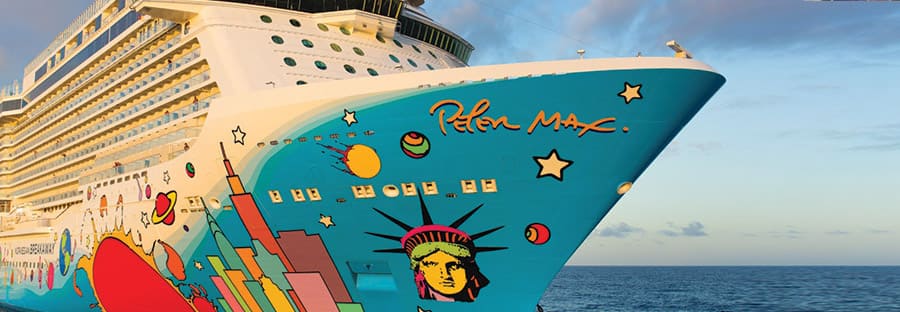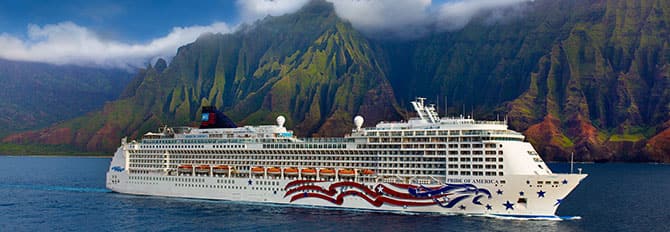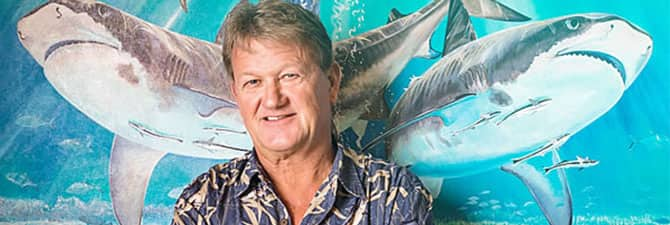
In 2014, Norwegian Cruise Line asked Guy Harvey, the world’s foremost marine wildlife artist, to design the signature hull art for Norwegian Cruise Line’s newest and largest ship, Norwegian Escape. Other elements of the design will span the length of the 1,065-foot vessel and feature two undersea scenes that blend seamlessly. Norwegian Escape will sail from Miami to The Caribbean beginning this autumn.
Harvey grew up in Jamaica and maintains his art studio in Grand Cayman, where he lives with his wife and two children. Latitudes Magazine asked the artist 10 questions about his passions and his largest artwork ever.
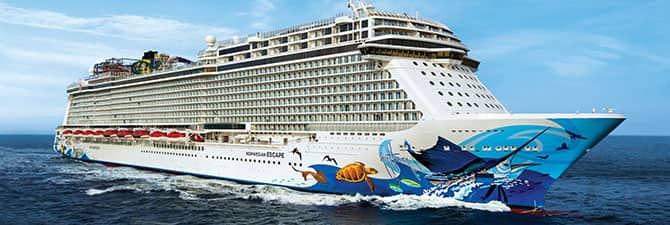
Latitudes Magazine: Tell us about your design for Norwegian Escape. How did it come about, and what challenges do you have working with such a large canvas?
GUY HARVEY: I used existing art images in a collage to place the different fish species along the hull of the Escape. Given the large format, it was a challenge to restrain myself and not pepper the hull with beautiful sea creatures that are endemic to the waters through which the Escape will be sailing. Because the Escape will be based in Miami, I chose the sailfish to be the figurehead art [the art will extend along the sides to the rear of the ship as well]. The sailfish is synonymous with South Florida, which is the boating and sport fishing capital of the world. I will be visiting the shipyard in Papenburg, Germany [where Norwegian Escape is being built] at the end of July to see the progress and to give some advice and to leave my personal mark on the ship.
LM: Where does your fascination with the sea spring from?
GH: I grew up in Jamaica with parents who loved to fish and snorkel. From an early age I loved being out on or in the water. As a student, I wanted to study fish, and so I pursued a scientific career in marine biology and later did my Ph.D. on fish biology and management of fisheries. Living in the Cayman Islands, the ocean is right there on my doorstep and I spend many hours enjoying diving.
LM: Your art reflects your love of sportfish. As an angler, what excites you most?
GH: I love all kinds of fishing, for different species and using different gear. I really love the big game fish such as the marlins, sailfish and tunas. They are powerful, majestic and beautiful. The best part is watching them swim away unharmed after an epic battle. The billfish are my favourite to catch because of their spectacular displays of jumps, which I love to capture on film. My favourite fishing spots in the Caribbean include St. Thomas and Puerto Rico for blue marlin, Venezuela for white marlin, Isla Mujeres, Mexico for sailfish, white marlin and mako sharks, as well as the Cayman Islands for dolphin, wahoo and tuna. Catching and releasing giant bluefin tuna off Nova Scotia, giant swordfish anywhere, big blue or black marlin anywhere in a number of locations, Panama or Australia is the greatest thrill available to an angler.
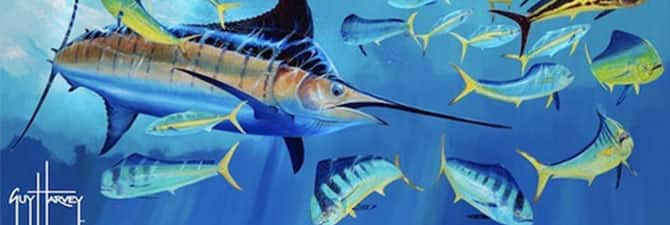
LM: How would you describe the state of the oceans today?
GH: The state of the oceans today is far from good. Overfishing continues as the human population grows and places more demands for seafood. Habitat destruction and pollution of marine ecosystems extend to coral reefs, seagrass beds and mangroves. Then add the effects of climate change. Many more countries now appreciate the value of living marine ecosystems not only for maintaining biodiversity, but also for the good of their economies and their people. It is our collective responsibility to conserve the marine environment and to maintain the biodiversity of the planet. Overall the Caribbean has a huge opportunity to conserve its marine ecosystems to maintain biodiversity and as a main attraction in the tourism sector. I am hopeful that people will do the right thing and make good choices.
LM: How concerned are you about climate change?
GH: Many governments have been slow to realize that the situation is not sustainable, and the planet is cooking slowly because of greenhouse gases generated by human activity. In addition, sea level rise will result from the melting of the polar ice caps. Combine these devastating effects with the greatest loss of species since the disappearance of the dinosaurs, and pretty soon more people will want to see action taken by both corporations and governments.
LM: Norwegian Escape will have industry-leading environmental technologies on board. What excites you most about working with Norwegian?
GH: Historically the cruise ship industry has had a bad reputation for the damage they have caused the marine environment. This is all changing as ships become more efficient and companies embrace sustainability. With Norwegian Escape, I will be hosting an onboard TV channel that will feature majestic marine creatures that I meet while sport fishing or diving in many locations. These documentaries have great educational content.
LM: Can you share some of your more memorable experiences at sea?
GH: Most of my expeditions include fishing and diving often in remote locations, such as Cocos Island, Costa Rica, or in Panama, or the Galapagos Islands. I have had many exceptional fishing and diving encounters with the great sharks, whales and billfish of the oceans. Encounters with these majestic creatures provide the drive to create paintings and bring them into people's lives through the medium of art.

LM: Tell us about the work of the Guy Harvey Ocean Foundation and the Guy Harvey Research Institute.
GH: The Guy Harvey Research Institute (GHRI) was started in 1999 and based at the Oceanographic Centre of Nova Southeastern University in Florida. I funded research work on sharks, billfish and tunas from income generated by my for-profit licensing business. The nonprofit Guy Harvey Ocean Foundation was started in 2007 to assist with educational outreach and fundraising. To date the GHRI has published over 80 scientific papers in the best journals and is a world leader in shark and billfish research work. I often film the work of the GHRI as the basis for my educational documentaries.
LM: How did the venomous lionfish arrive in the Caribbean from its native Pacific?
GH: The invasive lionfish originally came from the Western Pacific to Florida in the aquarium trade. As a voracious predator, they consumed all the other fish in people's aquaria, grew big and were then released into canals. These fish flourished in the warm, food-rich waters of the Bahamas and in the Caribbean and then exploded in numbers due to their high reproductive capacity and lack of natural predators. However, lionfish taste really good and are now the preferred fish to eat throughout the Caribbean, taking pressure off overfished species such as groupers and snappers. By increasing the demand for lionfish, more will be harvested from our reefs until natural forces can take a hold in controlling the lionfish population.
LM: As consumers of fish, what species should we avoid so as to promote their conservation?
GH: There are several Sustainable Seafood Guides available and the Guy Harvey Ocean Foundation publishes one online and in printed form. There are a few species of wild fish and crustaceans that are still caught sustainably, such as salmon and lobster as well as some species of tuna. Many species are fully exploited and so are to be avoided, and some are in a critically overexploited condition. The lionfish is now an obvious choice as are farm-raised tilapia, which will become the fish of the future.





